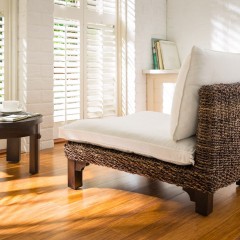7 Benefits of Engineered Wood Flooring
Solid wood flooring can be expensive and comes with many drawbacks such as a lack of flexibility in humid conditions. But when you choose engineered wood, you get a stylish product with many advantages. It makes the best use of natural resources and it’s just perfect for any room in your home. 1. Hard-Wearing Engineered wood is manufactured from multiple layers of timber. The lower planks are usually of less decorative wood such as pine. They can even be made from economical, ecological, recycled timber by-products or fibreboard. Several thin layers with a density similar to plywood are glued together. Then the top layer of real oak or a similar wood is applied to the surface. It’s this layered effect that gives engineered wood amazing flexibility and additional resistance to excessive footfall compared to a solid wood floor. It means your flooring can withstand the rigours of family life for many years to come. And providing you remember to give it a little attention every so often, it should still look as delightful as the day it was installed. 2. Economical Unlike its solid timber rival, engineered wood flooring is a cost-effective option. It only uses a thin top layer of attractive timber such as maple, beech or oak. This drastically reduces the expense of the timbers used for your floor despite the longer manufacturing process. The investment you make in choosing engineered wood flooring should be recouped when you balance out the expense of inferior materials. Vinyl and laminates are far less robust and only last for a fraction of the time. They’ll need replacing every ten years or so. On balance, the durability of engineered wood flooring makes it an ideal choice for your home against cheaper forms of flooring. 3. Fast Installation The manufacturing techniques to produce the timbers for engineered wood flooring incorporate all your installers need to make the job mercifully quick. Each plank includes shaping along each side for tongue and groove connection. It makes each plank simple to fit the next and produces a beautifully smooth surface that’s fixed firmly in place. Cutting each plank to correspond with the dimensions of your room is easier with engineered wood than with solid timber. It means your installers won’t have to work so long to complete the flooring. This helps with reducing the cost of installation. It gives you the chance to have your floor looking and performing perfectly due to a professional installation. But if you’re super confident, you can always opt for DIY. 4. Long-Lasting When you provide your home with flooring made of engineered wood, you know it will last for...
5 Top Tips on How to Look after Your Outdoor Swimming Pool
When you live in a warm climate, such as here in Australia, you’ll soon appreciate the benefits of having a swimming pool in your backyard. At Best Home Ideas, we know that it’s great for relaxing at the end of a busy day and adds even more fun to an outdoor barbecue party. Also, if you have water-loving dogs, such as Cavoodles, they’d probably enjoy dipping in with you on warm summer days. However, there is the problem of regular maintenance to ensure your pool stays clean and usable. Here’s our rundown of the most essential tips you’ll need: 1. Using a Pool Skimmer This is one of the easiest maintenance chores. It aims to remove the leaves, twigs, flies and anything else that may be floating on the water’s surface. You can reduce the amount of debris by designing your garden with pool-friendly surroundings. To remove pool litter, take a long-handled pool skimmer with a wide net for greater coverage. Then simply work your way across the pool by skimming debris off the water. Empty it into a bucket then dispose of it in an area of your garden where it can’t directly blow back in. This task is best done daily or at least every time you’re about to dive in the pool. If you neglect floating debris, it eventually sinks to the floor of the pool. It then decays and can permanently stain the flooring. 2. Remove Algae An important part of pool maintenance is removing algae. The spores of these simple plants easily blow into the water. In sunlight, the warmth encourages them to multiply fast. They can appear in different colours such as red, brown or green and stick like glue to any hard surface in your pool. Swimming in algae-ridden water can be harmful and make you feel ill. Acoording to Ray Brosnan, the co-owner of Brosnan Property Solutions, a property maintenance company, the remedy is to use a truly good and quality pool brush once a week to dislodge them. Every area of the pool needs to be brushed, and it’s best done in the pool’s direction’s drain. Another helpful tip is to brush everywhere after chemical treatment to disperse them effectively. 3. Pool Vacuuming Regardless of how thorough your pool skimming technique becomes, debris will always find its way to the bottom of your swimming pool. The most effective way to remove it is with a pool vacuum. There are two versions to choose from. A hand-held pool vacuum is relatively inexpensive because you do all the work. It consists of an extending pole with a vacuum head at the end....
Can Solar Panels Save You Money in Australia?
In the typical Australian home, high-quality solar panels should save you money long-term. They could even eliminate using electricity from the grid. However, the average energy costs of an Australian home can vary. The variations of location and individual demands can drastically alter the money-saving potential of solar panels. How Much Money Can You Save with Solar Panels? The following calculation suggests the savings that an average Australian home can make through the installation of solar panels. It doesn’t include a feed-in tariff, where you sell surplus electricity to the grid. Energy usage in different households varies enormously depending on individual requirements. But when you make a balanced estimation, the typical Aussie home might use 8,000 kW per annum. This could cost you around $3,200 for the year. A standard solar panels installation could generate the 8,000 kW you need in its first year of use. But let’s assume it only provides three-quarters of your requirements, with the remainder supplied by the grid. You could still save $2,400. Recouping Your Investment in Solar Panels The cost of solar panels with an average 6.6 kW output could be approximately $6,500. A high-quality system should last at least twenty-five years. Based on the above savings, you could recover the installation costs in about three years. It means that for the remaining twenty-two years, you could save a massive $52,000. But what if your electricity consumption was so great, solar panels could only supply half your needs? You should still be able to pay off the initial cost after four years. You could then save around $33,000 over the lifetime of your solar panels’ system. Of course, over twenty-five years, your household’s requirements could alter. Your kids might leave home, reducing your electricity usage even more. But then, this benefit could be offset when you switch to vehicles that require electrical recharging overnight. Can Solar Panels Increase the Value of Your Home? The threat of irreversible climate change is encouraging the use of renewable energy such as solar panels. Government data reveals there were 2,897,835 new installations by the end of July 2021. Let’s assume these are high-quality installations of at least 5 kW. They’ll not only provide savings on electricity bills, but they could also increase the value of each home by an estimated $30,000. What if you invest in high-quality solar panels worth approximately $6,000 immediately before selling your home? They could theoretically pay for the installation five times over. You’d make a profit even after investing in solar panels for your new home. Effective Battery Storage Self-sufficiency from the grid is only realistically achievable if you add battery storage....














